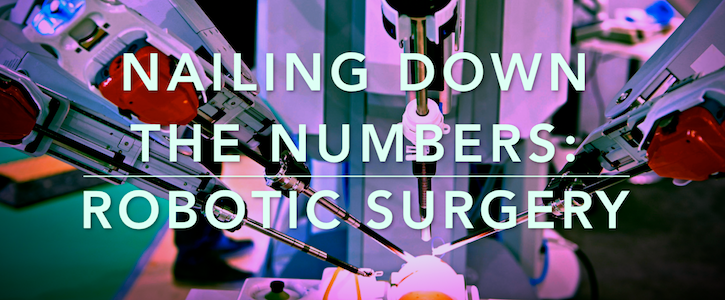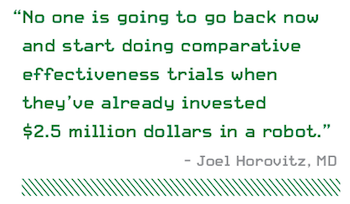- Politics
- Diversity, equity and inclusion
- Financial Decision Making
- Telehealth
- Patient Experience
- Leadership
- Point of Care Tools
- Product Solutions
- Management
- Technology
- Healthcare Transformation
- Data + Technology
- Safer Hospitals
- Business
- Providers in Practice
- Mergers and Acquisitions
- AI & Data Analytics
- Cybersecurity
- Interoperability & EHRs
- Medical Devices
- Pop Health Tech
- Precision Medicine
- Virtual Care
- Health equity
Nailing Down the Numbers Surrounding Robotic Surgery
The practice seems like it’s ripe for data and analytics, and that’s true—to an extent.

Leonardo da Vinci spent the end of his life dissecting cadavers, trying to figure out what makes humans feel, react, and survive. It was the coda of a lifelong obsession with human design and function, which also birthed what some consider the first automated technology. Now, Intuitive Surgical’s groundbreaking da Vinci robotic surgery device bears the innovator’s name, because of both his early invention and deep interest in human anatomy.
But the modern machine contains little of the humanity that the original Renaissance man so idealized: With its 4 sleek, imposing arms, the surgical tool resembles a spider. The robot’s applicability varies across specialties; although it has become the standard of care for some procedures, it has yet to make a dent in others. At more than $1 million, da Vinci robotic surgical devices carry a high cost that is compounded by 6-figure annual required maintenance contracts. Even so, they have managed to enter thousands of American hospitals. Intuitive Surgical also released a “value minded” version of the device in 2017, designed to spur further adoption.
Some say the da Vinci expands the ways that surgeons can do their work, eliminating the inevitable tremor of a human’s hand and adding multidimensional views of the procedure. They also argue that it has the potential to create standardization and precision that the field has never seen before. Critics say the device merely adds time at the expense of touch and that claims of true comparative supremacy have not been validated.
What matters most, however, is what the data suggest.
The General Surgeon

At first, Joel Horovitz, MD, was enthusiastic about robotic surgery. When the machines began to enter operating rooms, Intuitive established a training center at East Carolina University in Greenville, where Horovitz practiced on the first iteration of the da Vinci. Afterward, he began using the machine in some procedures but eventually gave up due to the added “hassle,” he said.
A general surgeon at Maimonides Medical Center in Brooklyn, New York, Horovitz describes himself as a skeptic of the machines. It’s not that he doesn’t recognize their benefits, like the lack of tremor and the multiple views. It’s that he doubts the evidence base that surround them.
Randomized controlled trials can’t be done with surgery the way they are with drugs. An investigator, for example, can’t in good conscience give a person a placebo surgery. Still, Horovitz compares the efforts of robotic surgery machine makers to those of pharmaceutical companies. “Almost all the articles that have been written about the supremacy of the robot have been by researchers paid by Intuitive,” he said, citing a 2015 literature review that found spin in over 80% of published studies on robotic surgery between 1992 and 2014.
According to Horovitz, “superb salesmanship” has led to the adoption of robotic surgery, more so than any proven benefit. It also involves another financial opportunity for Intuitive—selling its multiview console.
“No one is going to go back now and start doing comparative effectiveness trials when they’ve already invested $2.5 million dollars in a robot and they have a $100,000 per year maintenance contract,” Horovitz said. “It’s just too damn expensive to do that.”
He also thinks that the robots make it harder to train future surgeons, extending the learning curve. Rather than observing and slowly increasing their participation, as in open or laparoscopic surgery, residents simply stand by the bedside with nothing to do as the surgeon manipulates the robotic arms.

The Thoracic Surgeon
John Lazar, MD, said the machines make hospitals more attractive to prospective surgeons. “You’re not going to attract a new surgeon if you don’t have it. You’re not going to get a urologist or a gynecological oncologist when that’s literally the standard of care for them,” he said. “Forget thoracic and general surgery. To attract the new talent, you’ll have to have it.”
Many surgeons like to use the da Vinci, Lazar said, and that group isn’t composed only of young ones: He pointed to a 68-year-old surgeon who was one of the most prolific da Vinci users in the country.
Lazar is a thoracic surgeon at MedStar Georgetown University in Washington, DC, and its director of Thoracic Robotics. Although he understands the issues that skeptics like Horovitz raise—expense, lack of haptic feedback, and limited comparison studies—he expects most of those issues to be resolved in time.
“A surgeon now has 360 degrees of wristed movement with 3-D visualization,” he said. “We are doing things we really couldn’t do before, and it’s ever expanding.” Lazar expects a form of haptic feedback to be instituted eventually but said that the current lack of it does not hinder his ability to operate gently and precisely.
The da Vinci also has given Intuitive a near monopoly on the market, which experts said can chill innovation and keep prices steep. New features and lower prices will come when someone decides to be the Nikon or Fuji to Intuitive’s Kodak, Lazar said.
One of the biggest deficiencies right now, he said, is the lack of standardization. Industries pursue automation to ensure consistency and quality, but guidelines regarding use of robots do not yet exist.
Each healthcare system has different criteria for credentialing their surgeons, Lazar said. Intuitive offers an online course that may be required, and test labs enable surgeons to use the robot to build muscle memory and practice operations on animals or cadavers. After that, a surgeon might have 20 to 30 proctored cases for which they have a preliminary privilege to operate, with mentoring continuing until the surgeon is trusted.
“One of the things that’s got a lot of movement right now is standardization. So, whether you’re in Arizona or you’re in New York, there’s a standard for things like cost and length of procedure,” Lazard said. But developing such guidelines would require defining both best uses and quality measures.
The Urologic Surgeon
Robotic surgery seems ripe for standardization and quality measurement. A team at the Keck School of Medicine of the University of Southern (USC) in Los Angeles recently ran a pilot study on a black box for the da Vinci that could inform such consistent use. Andrew Hung, MD, a urologic surgeon and robotics researcher, led the study. The experimental technology, which records all the robot’s output data, paired with the video it captures, would allow any surgical procedure performed with a da Vinci to be re-created in 3-dimensional space.
If one can re-create the work of both a good surgeon and a bad surgeon, Hung said, one can begin to define better validation standards that will deliver consistent patient outcomes. That could come well down the line, though—the study was just a pilot-run one, and all the tools for processing the data must be built from the ground up, never mind the analytics that could compare surgeon performance.
Still, Hung likes that robotic surgery could remove at least 1 human element. Traditionally, surgeons earn the right to perform surgery based on assessments from other surgeons. “The problem is that even when using thoroughly validated assessment tools, there’s going to be disagreement,” Hung said. “The goal of our study is to utilize objective data that comes directly from the robot as the surgery is being performed. There is no human bias in there.”
Machines like da Vinci have claimed the greatest foothold in urologic surgery. Hung said that in his facility, and others nationwide, radical prostatectomies are almost universally performed using the robot. Where Horovitz might see a shiny device that adds time and expense, Hung sees dexterity that could level the playing field. “This kind of technology has allowed more surgeons to operate at a level that they may not have been able to otherwise,” he said.
As always, the question of true automation arises: If the machine has an advantage over the human hand because of its precision, and it is capable of producing sufficient data to one day model and re-create the perfect surgery, will it eliminate the surgeon?
“Some folks have asked if what I am doing is putting the nail in the coffin for my own profession,” Hung said. “That may be an outcome, but it’s likely many, many years down the line.”
Podcast: Match Made in Hospitals — Patient-Matching Technology Can Improve Healthcare
September 21st 2021Clay Ritchey, CEO of Verato, highlights the administrative and financial benefits that patient-matching technology can provide hospitals and health systems, as well as how it can improve the patient experience.
Podcast: Using Digital Solutions to Address Technology Shortfalls with Citius Tech Senior VPs
July 29th 2021In an interview recorded earlier this year, Chief Healthcare Executive Associate Editorial Director Mary Caffrey spoke with 2 leaders of Citius Tech about meeting healthcare challenges with digital solutions.
